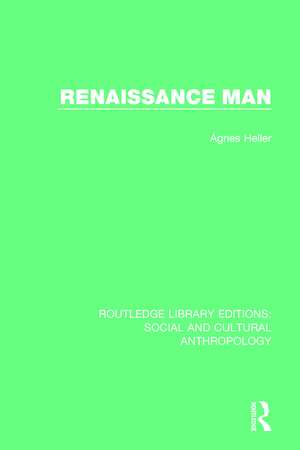Renaissance Man: Routledge Library Editions: Social and Cultural Anthropology
Autor Ágnes Helleren Limba Engleză Paperback – 14 aug 2017
| Toate formatele și edițiile | Preț | Express |
|---|---|---|
| Paperback (1) | 356.44 lei 6-8 săpt. | |
| Taylor & Francis – 14 aug 2017 | 356.44 lei 6-8 săpt. | |
| Hardback (1) | 995.07 lei 6-8 săpt. | |
| Taylor & Francis – 21 iul 2015 | 995.07 lei 6-8 săpt. |
Preț: 356.44 lei
Nou
Puncte Express: 535
Preț estimativ în valută:
68.20€ • 71.47$ • 56.38£
68.20€ • 71.47$ • 56.38£
Carte tipărită la comandă
Livrare economică 11-25 aprilie
Preluare comenzi: 021 569.72.76
Specificații
ISBN-13: 9781138927544
ISBN-10: 1138927546
Pagini: 492
Dimensiuni: 156 x 234 x 25 mm
Greutate: 0.45 kg
Ediția:1
Editura: Taylor & Francis
Colecția Routledge
Seria Routledge Library Editions: Social and Cultural Anthropology
Locul publicării:Oxford, United Kingdom
ISBN-10: 1138927546
Pagini: 492
Dimensiuni: 156 x 234 x 25 mm
Greutate: 0.45 kg
Ediția:1
Editura: Taylor & Francis
Colecția Routledge
Seria Routledge Library Editions: Social and Cultural Anthropology
Locul publicării:Oxford, United Kingdom
Public țintă
Postgraduate and UndergraduateCuprins
Introduction: Is there a ‘Renaissance Ideal of Man’? Part 1. Uneven Development Part 2. Antiquity and the Judeo-Christian Tradition 1. Secularization 2. A Glance at the Past 3. Stoicism and Epicureanism 4. Ecce Homo: Socrates and Jesus Part 3. Ethics and Life: Man’s Practical Possibilities 5. Everyday Life 6. Time and Space: Past-Orientedness and Future-Orientedness 7. Individuality, Knowledge of Men, Self-Knowledge, Autobiography 8. Measure and Beauty: Emotional Ties 9. Values and Ethics 10. Social Philosophy, Politics, Utopia 11. Fate, Destiny, Fortune Part 4. Philosophical Anthropology 12. Nature and Man 13. Work, Science, Techné, Art 14. Knowledge; Body and Soul 15. What is Man Capable of?
Descriere
Considering such witnesses of the time as Shakespeare, Dante, Petrarch, Michelangelo, Machiavelli, Montaigne, More and Bacon, Agnes Heller looks at both the concept and the image of a Renaissance man. The concept was generalised and accepted by all; its characteristic features were man as a dynamic being, creating and re-creating himself throughout his life. The images of man, however, were very different, having been formed through the ideas and imagination of artists, politicians, philosophers, scientists and theologians and viewed from the different aspects of work, love, fate, death, friendship, devotion and the concepts of space and time. Renaissance Man thus stood as both as a leading protagonist of his time, one who led and formulated the substantial attitudes of his time, and as one who stood as a witness on the sidelines of the discussion. This book, first published in English in 1978, is based on the diverse but equally important sources of autobiographies, works of art and literature, and the writings of philosophers. Although she uses Florence as a starting point, Agnes Heller points out that the Renaissance was a social and cultural phenomenon common to all of Western Europe; her Renaissance Man is thus a figure to be found throughout Europe.

















